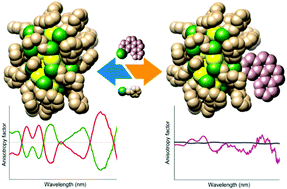Ligand exchange reactions on the chiral Au38 cluster: CD modulation caused by the modification of the ligand shell composition†
Abstract
Ligand exchange reactions have become a highly versatile post-synthetic strategy to accurately engineer the ligand shell of atomically precise noble metal nanoclusters. Modifying the chemical structure of the exchanging ligand with chromophore substituents or adding chiral centers allow direct functionalization of the cluster with desired properties. As such, post-functionalized gold nanoclusters with unique physicochemical properties find applications in optoelectronics, catalysis and biomedicine. Herein, we successfully carried out ligand exchange reactions between the chiral Au38(2-PET)24 cluster (both racemic and enantiopure forms) and the helically chiral but configurationally labile 2-thio[4]helicene ligand (TH4). The reaction products with a composition of Au38(2-PET)24−x(TH4)x were analyzed using UV-vis spectroscopy and MALDI mass spectrometry. It was found that up to ten 2-PET ligands can be replaced with the helicene ligand on the cluster surface according to MALDI analysis. Consequently, the UV-vis and CD spectra of the cluster have been strongly affected by the ligand exchange reaction. The intensities of the CD signals of Au38(2-PET)24−x(TH4)x were drastically reduced and red shifted with respect to the reference Au38(2-PET)24 cluster. Moreover, the appearance of the other enantiomer in the HPLC chromatogram revealed the partial racemization of the cluster. DFT calculations were performed and they support the experimental observations and show that the observed chiroptical changes in UV-vis and CD spectra are exchange-site dependent. The calculations also demonstrate that charge transfer (CT) transitions occur between the Au38 cluster and the helicene ligand. Thus the ligand is directly involved in these transitions and contributes to the electronic states comprising those transitions.



 Please wait while we load your content...
Please wait while we load your content...